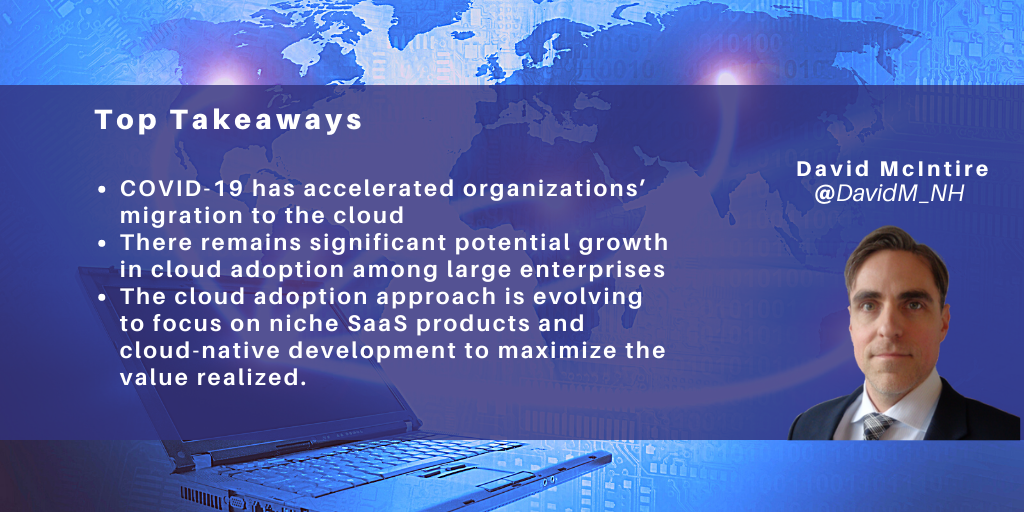posted on Jul 27, 2020 by NelsonHall Analyst

As financial results that reflect a full quarter in the shadow of the COVID-19 pandemic are being released by IT service vendors, one of the key themes is that while discretionary budgets are being hard hit, clients’ investment in migrating to the cloud is not slowing. For vendors, clients’ cloud adoption has acted as a mitigator of other areas where clients have delayed new programs or delivery has been slowed by the move to remote working. Some specific examples:
- While IBM saw revenue decline across its other services, it reported strong growth in its cloud business (in part driven by its acquisition of Red Hat)
- TCS highlighted cloud as a growth driver, with its pipeline reflecting accelerated enterprise-wide adoption of cloud
- Wipro highlighted demand being driven by 3 Cs – cloud, collaboration and cybersecurity.
The reason for this is clear: companies are focusing on reducing operating costs in the face of uncertain revenues and an unknown economic recovery timeline. They are also looking at a significantly more distributed workforce for the foreseeable future.
Cloud migration is rising even in sectors that have historically been slow to adopt cloud. Financial services has long been a laggard in cloud adoption due to the myriad regulatory and security challenges, but this month has seen large cloud engagements announced by HSBC (with AWS) and Deutsche Bank (with GCP).
Cloud has long been one of the fastest growing, and most hyped, areas of IT services. But NelsonHall research shows that despite the ubiquity of cloud in discussions of IT services, it still has a long runway of adoption among large enterprises. And the approach to cloud migration is seeing changes that impact how IT service vendors shape their cloud offerings and capabilities.
Hybrid Cloud Penetration Still Has Room to Grow
NelsonHall research into the priorities and focus areas of over 1,000 IT service buyers globally conducted earlier this year revealed that while cloud has been a focus area, there is still considerable growth remaining.
Globally, our survey shows that just over a third of large enterprise infrastructure landscapes are housed in the cloud today, very much in line with the planned adoption rate identified in previous NelsonHall surveys. But our most recent survey indicates that buyers are now expecting to house 42% of their landscapes in the cloud by 2022.
And hybrid cloud will remain the dominant cloud adoption strategy going forward.
Vendors Need to Evolve Cloud Capabilities
While cloud adoption shows no signs of slowing, it is important to realize that how cloud is being adopted is changing. Whereas early cloud adopters focused on lifting and shifting existing applications, standing up non-critical or non-production workloads or adopting common SaaS-based enterprise applications, clients are increasingly focusing on more tailored cloud adoption to drive higher return on investment.
The first major shift is the increasing importance of cloud-native. In 2018, NelsonHall estimated 23% of cloud migration work focused on cloud native development and projected this would rise to 32% by 2020. In our more recent survey, the most commonly prioritized characteristic that buyers seek in their vendors is cloud-native development capabilities. This is highly important to 81% of buyers globally and is the highest prioritized capability in nearly all of the 18 sectors we analyzed.
The other major priority shift is the greater specialization or tailoring that buyers are looking for in SaaS-platforms. Adoption of SaaS-based applications has been a consistent priority for IT service buyers for some years now and this continues to be the case, with 66% of buyers placing high importance on implementing new SaaS solutions. But clients are now looking for SaaS products tailored specifically to function or sector requirements. After cloud-native development, prioritized vendor capabilities include vendors that bring their own digital application offerings and have in-depth knowledge of sector-specific digital offerings.
In short, buyers increasingly aren’t lifting and shifting to the cloud just to realize some level of infrastructure cost reduction; they are looking to leverage the cloud to improve their application landscapes through more tailored adoption strategies. They need vendors that can develop a customized cloud adoption roadmap which combines commercially available SaaS products that address specific needs and, when those aren’t adequate, the replacement of on-premise applications with custom cloud-native developed ones.
Vendors Need to Continue Cloud Investment
All of these trends provide a blueprint for IT service vendor investments to ensure maximum relevance for their clients. IT service vendors need to be building a bench of resources with cloud-native development capabilities as well as cloud consulting capabilities. They also need to be investing in an understanding of SaaS offerings that are tailored to specific sector or business functions as well as exploring developing their own niche applications for areas where they possess strong capabilities and client relationships. Cloud adoption may be maturing but it still has a long way to go, and this is one area where the pandemic has only increased demand.

Jul 28, 2020, by Brenda Celeste